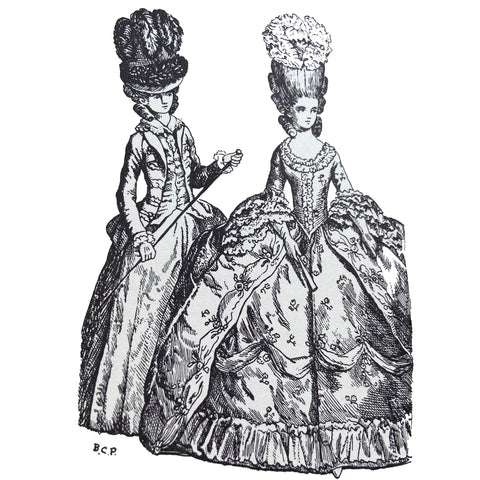A Brief History of the Riding Habit
To coincide with our latest collection of hand tailored riding skirts (now out of stock, but do get in touch if you would like us to stock more like this), we decided to delve a little deeper into the history of the riding habit. Protective overskirts, or ‘safeguards’, have been worn for riding since the 16th century. Possibly the first use of the term ‘riding habit’ was by John Evelyn in his diary on 13th September 1666, when he mentioned that The Queen was wearing her ‘cavalier riding habit’. The word ‘habit’ in this case means ‘clothing’ or ‘attire’.
Since the mid-17th century, the formal habit for riding sidesaddle usually comprised of: a tailored jacket (riding coat, or redingote) with a matching long skirt, a tailored shirt/chemise and a hat (usually a top hat with a veil from the Victorian era). The first habits adopted elements of men’s attire and were often inspired by military uniform. A caption to a 1779 drawing by John Downman in the Fitzwilliam Museum describes, “The Lady of Henry Bunbury in the Suffolk Militia uniform, the fashion of the day.” By the end of the 17th century, women had largely taken over the making of women’s clothes from men, but tailors continued to create women’s riding habits.
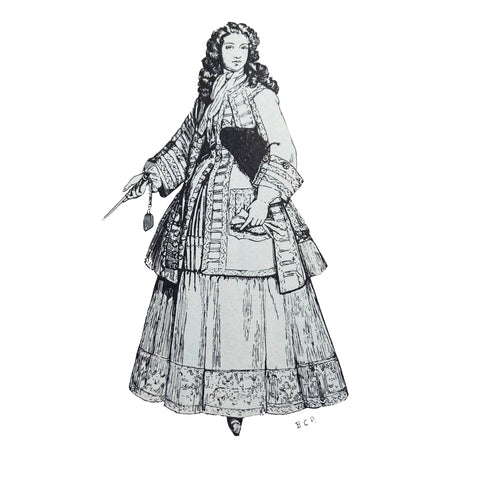
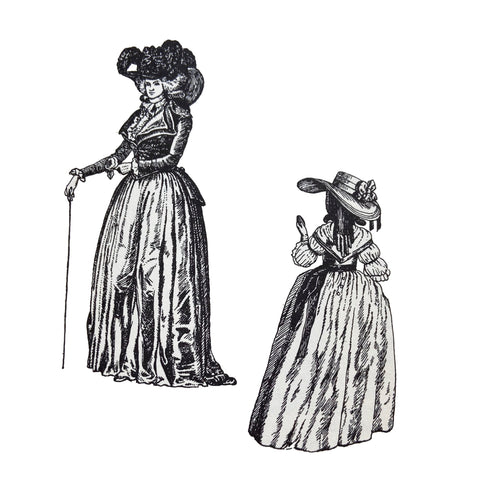
Riding habit with ruffled chemise-front and lapelled waistcoat from 1785 on left, and back view of gown from 1786 on left, illustration by Barbara Philipson
According to the Jane Austin Centre, “as equitation was considered an art and a courtly pastime, elaborate trimmings and materials were used, such as the brocade of the Restoration period and beyond.” Designs were initially influenced by the French Court, but throughout the 18th century became increasingly related to English hunting and the country gentleman - becoming plainer, and more functional. They also started to be worn for travelling and as informal daywear (not just for following the hunt), and were soon an essential part of the fashionable middle and upper-middle class woman’s wardrobe. The fact that habits tended to be floor length or just a few inches off the ground meant that they were not entirely practical for riding.
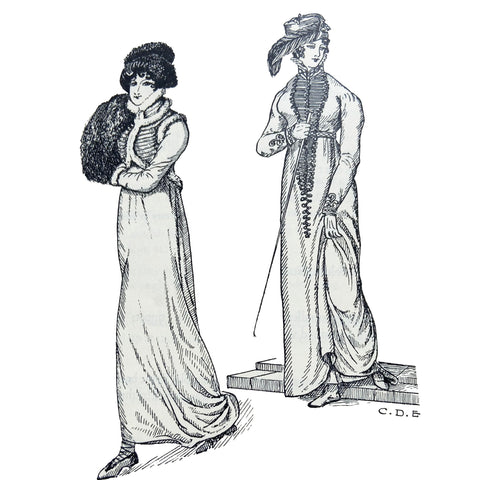
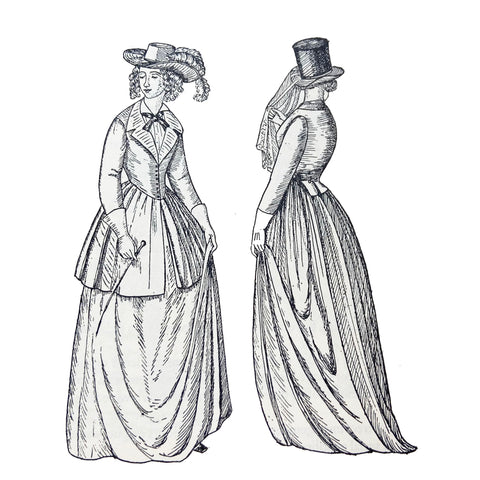
Two styles of riding costume, the first wearing a habit with a polka skirt over the riding skirt from 1843, illustration by Phillis Cunnington
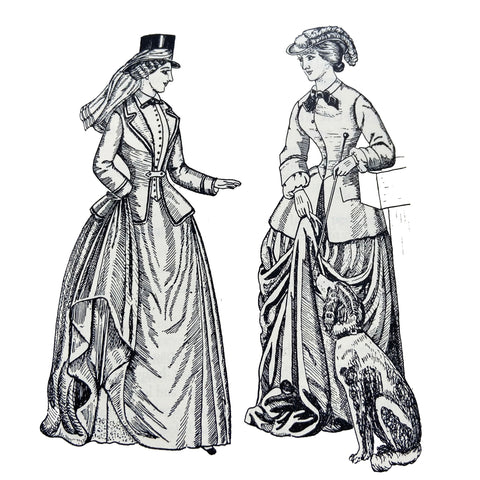
Riding habit from 1852 on left and 1859 on right, illustration by Phillis Cunnington
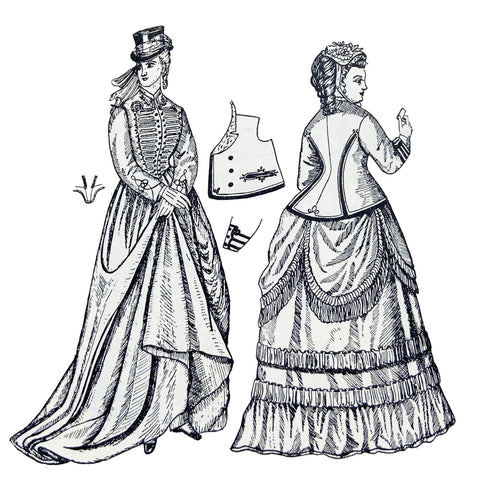
Riding habit from 1870 on left and double breasted jacket with walking dress on right, illustration by Phillis Cunnington
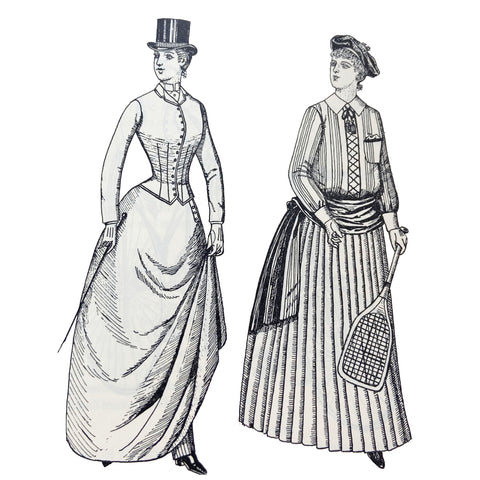
Riding habit and tennis costume from 1888, illustration by Phillis Cunnington
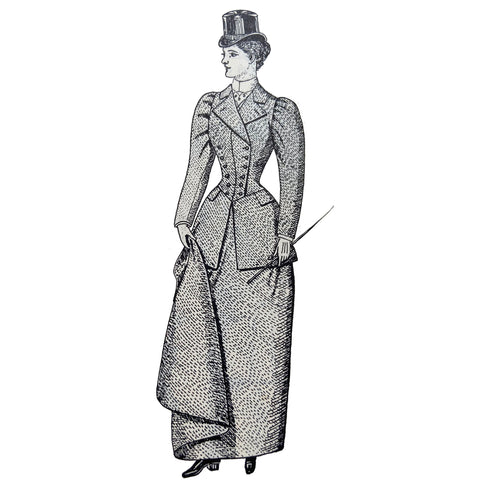
Riding habit from 1894, illustration by Phillis Cunnington
The 1880s to the 1930s were the heyday of sidesaddle riding, which was considered the only proper way for a lady to ride on horseback – a custom rapidly dispensed with during the Second World War. According to Janet Arnold, in the second half of the twentieth century, this practice fell out of favour for women, and was regarded as a minority pursuit and an archaic, even oppressive, symbol of a bygone age: “Side saddles, at this time, were broadly the reserve of pageants and historical re-enactments, and the preserve of female British Royals including Queen Elizabeth II, on state occasions.” In 1959, American author and horsewoman, Lida Fleitmann Bloodgood, lamented that riding aside had had its day and was, “as much an anachronism as the cabriolet, the crinoline, and the minuet.”
The Side Saddle Association later rekindled the elegance of this traditional style of riding. Initially called the Ladies Side Saddle Association, the organisation was established by Valerie Francis and Janet Macdonald in 1974. Over recent years, sidesaddle riding has undergone a revival.
Nevertheless, you don’t have to ride sidesaddle to wear a riding skirt. The Nouvelle Habit riding skirts at ShopCurious are designed with contemporary rider in mind, and are a modern twist on the old classic. Founder Odette Insoll’s brand uses the word ‘habit’ to retain a connection with tradition, but she also wanted to incorporate an element of romance, hence the word ‘nouvelle’, which resonated with her own French name.
Odette thought carefully about her brand’s logo, and eventually chose the rose, representing ‘beauty and grace’ in the colours of wintry blue, representing ‘truth and loyalty’, autumnal orange for ‘worth and ambition’, and red for ‘love’. The gold background symbolizes ‘generosity’. Odette even uses as wax seal of her logo to signify “more traditional times and integrity.” And the logo is stamped by hand onto leather buckles and elements of the skirt’s lining to reinforce qualities that form the cornerstones of the Nouvelle Habit brand. In short, these skirts combine the history and provenance of a bygone era with the practicality required by passionate riders of the 21st century.
Sources:
Arnold, J. (1999). Dashing Amazons: The development of women’s riding dress, c. 1500–1900. A. de la Haye & E. Wilson (eds.). Defining dress: Dress as object, meaning and identity. Manchester University Press. Manchester. pp. 10–29.
Cunnington, C.Willett and Phillis (1959). Handbook of English Costume in the 19th Century. Faber and Faber Limited, London. Illustrations by Phillis Cunnington and Cecil Everitt.
Cunnington, C.Willett and Phillis (1957). Handbook of English Costume in the 18th Century. Faber and Faber Limited, London. Illustrations by Barbara Phillipson and Phillis Cunnington.
Fleitman Bloodgood, L. (1959). The saddle of queens: The story of the side-saddle. J. A. Allen & Co. London.

